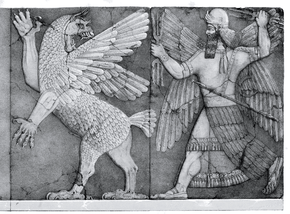Kulullû
Kulullû, inscribed ku6-lú-u18/19-lu, "Fish-Man", an ancient Mesopotamian mythical monster possibly inherited by Marduk from his father Ea. In later Assyrian mythology he was associated with kuliltu, "Fish-Woman", and statues of them were apparently located in the Nabû temple in Nimrud, ancient Kalhu, as referenced on a contemporary administrative text.[1]
| Part of a series on |
| Ancient Mesopotamian religion |
|---|
 Chaos Monster and Sun God |
|
Seven gods who decree
|
|
Other major deities |
|
Demigods and heroes
|
| Related topics |
Ritual uses
He had the head, arms and torso of a human and the lower body and tail of a fish and was portrayed in sculptures found in palaces and on kudurrus. With a bitumen smeared clay figurine, he seems to have found special purpose attracting prosperity and divine benevolence to households, as his icon was inscribed ri-da hi-ṣib KUR-i er-ba taš-mu u ma-ga-ru, "come down abundance of the mountain, enter intercession and compliance".[2]
He appears in Mesopotamian iconography from the Old Babylonian period onward. The Agum-Kakrime Inscription places his apotropaic icon on the gate of the ká-su-lim-ma, the chamber of Marduk and his divine consort Zarpanītu. He was one of the eleven monstrous spawn of Tiāmat in the Epic of Creation, Enûma Eliš. He is one of the demons listed in tablet VIII of the Šurpu incantation series, the ritual to counter a curse of unknown origin. He also features in a hymn to Marduk and the gods of the Esagila.[3]
His depiction in Assyrian reliefs is limited to a marine scene in Sargon II's palace at Khorsabad, ancient Dur-Šarru-kên, a small relief at Tell Halaf and on an ornamental brass ring found at Har Sena'im, an Ituraean cult site on the southern slopes of Mount Hermon.[4]
References
- D. T. Potts (2012). A Companion to the Archaeology of the Ancient Near East. Wiley-Blackwell. p. 234. External link in
|title=(help) - F. A. M. Wiggermann (1992). Mesopotamian Protective Spirits: The Ritual Texts . Styx Publications. pp. 52–53. External link in
|title=(help) - Takayoshi Oshima (2011). Babylonian Prayers to Marduk. Mohr Siebeck. pp. 67–68. External link in
|title=(help) - E. A. Myers (2010). The Ituraeans and the Roman Near East: Reassessing the Sources. Cambridge University Press. p. 176. External link in
|title=(help)